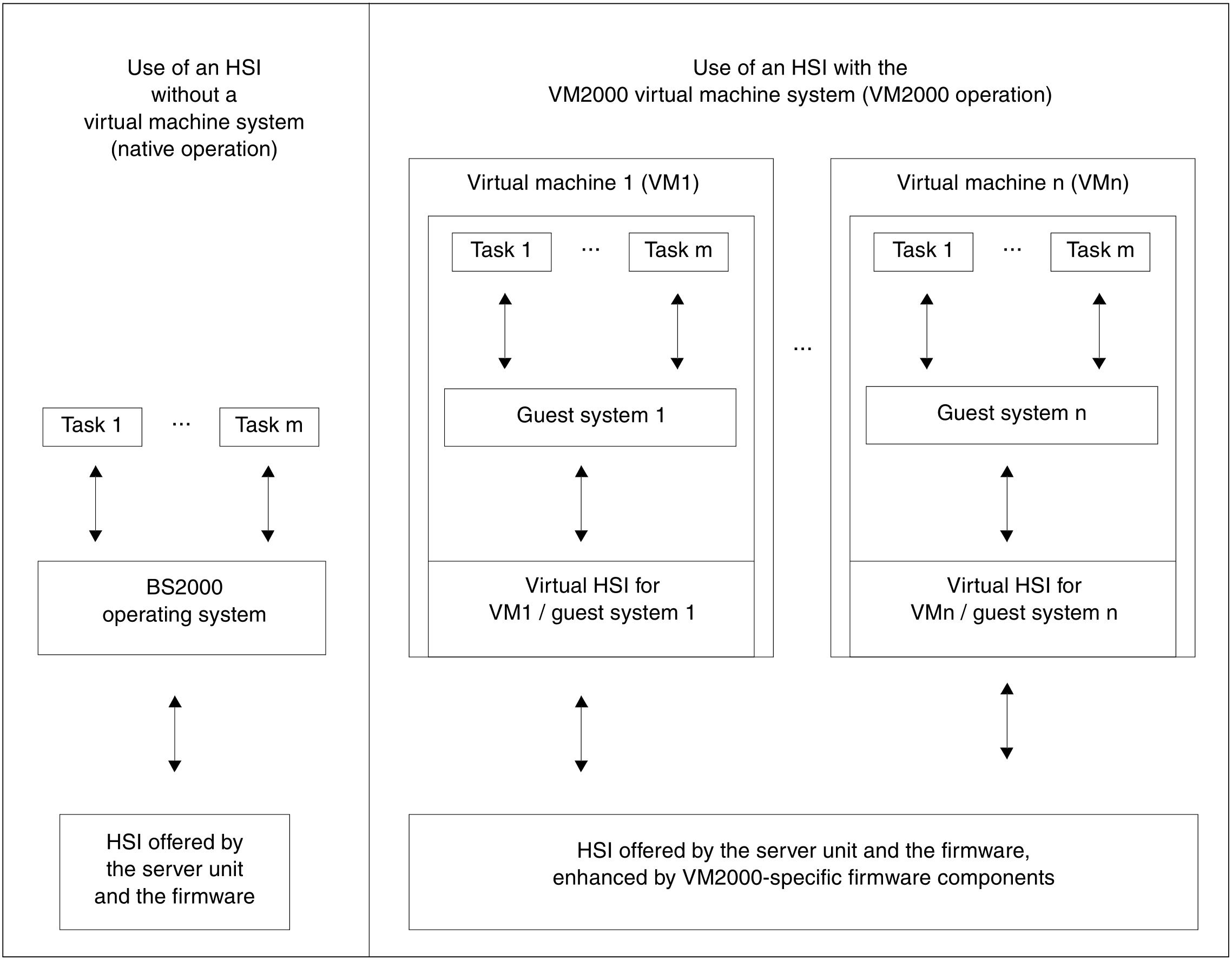VM2000, virtual machine, guest system
The VM2000 virtual machine system is a software product which implements more than one virtual machine (VM) on one real SE server (more precisely: on a Server Unit of the SE server).
From the user’s point of view, a virtual machine is a Server Unit on which his/her operating system, the guest system, runs.
Monitor VM, monitor system
A special BS2000 guest system, the monitor system, in which the VM2000 monitor, the administration application $VMCONS and the other VM2000 components are embedded, is provided to execute and manage VM2000. The monitor system runs on a special VM, namely the monitor VM.
The monitor VM not only serves to control the operation of virtual machines but, like any other VM, can also be used for the standard applications described on "Possible areas of application for VM2000".
VM2000 monitor
The VM2000 monitor is the central part of VM2000 for operating the virtual machines using VM2000 commands. It implements communication both between the user and VM2000, and between VM2000 and the hardware-related components, in particular the hypervisor (see the next page).
The VM2000 monitor is implemented in the monitor system as the VM2-MON subsystem.
VM2000 administration application $VMCONS
Operation of the VMs is normally conducted from a privileged user task in the monitor system. BS2000 consoles for the guest system are as a rule available to operate the guest systems. See section "VM2000 Operating strategy".
The administration application $VMCONS (optional, see "VM2000 administration application $VMCONS") can be used as an alternative to these recommended administration and operating media.
VM2000 dump
A special VM2000 dump for diagnostics can be created using the VMDUMP utility routine.
In the event of an error, the VM2000 dump is created automatically by VM2000 using the VMDUMP utility routine.
The VM2000 dump is not required for regular operation of VM2000.
VM2000 in the BS2000 guest systems
Each BS2000 guest system has communication interfaces to VM2000 in order to receive information on VM2000 operation and to introduce VM2000-specific actions in the guest system (implicit device assignment, for example, see "Assignment sets, implicit device assignment and release").
These interfaces are described in detail in section "VM2000 in the guest systems".
Hypervisor
A hypervisor controls the execution of the guest systems on the VMs. In particular it virtualizes the global resources CPU and main memory and starts execution of the operational guest system’s CPUs on the real CPUs (scheduling).
| On SU /390, the VM2000 hypervisor is a separate load module of VM2000 which is loaded (automatically) when VM2000 operation is initialized. | |
| On SU x86, the Xen hypervisor performs this role. Some of the hypervisor tasks are performed by the carrier system X2000. |
Hardware-software interface (HSI)
In technical terms, when operating virtual machines the hardware-software interface (HSI) which the Server Unit offers for an operating system is copied and made available for all VMs and their guest systems (see Figure 2). The (copied) HSI for a VM or a guest system is referred to as a virtual HSI.
Differences between SU /390 and SU x86 with respect to the HSI
| SU /390 are systems with a /390 architecture. The BS2000 operating system uses the HSI of the SU /390 (the real HSI) directly here. | |
| SU x86 are systems with an x86-64 architecture. The BS2000 operating system uses the nonprivileged, real HSI of the SU x86 here and the privileged HSI which is provided by the firmware. |
For further information on the technical structure of the SE servers and on the system environment, see the manual “Operation and Administration” [19].





